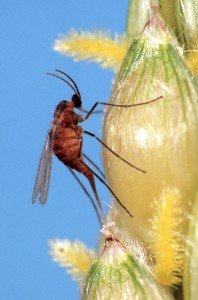
Female sorghum midge laying eggs in sorghum floret.
Sorghum midge (Stenodiplosis sorghicola) is a small (1.5-2mm) orange mosquito-like fly that lays its eggs into the developing flower spikelets. Larvae feed on the developing ovary, which prevents seeds developing normally. Hosts include grain sorghum, forage sorghum, Johnson grass, and Columbus grass, but does not attack Australian native Sorghum spp.
High populations on non-resistant varieties can completely destroy a sorghum crop. Feeding creates a depression in developing seeds and prevents seed kernel development. Damage by sorghum midge can be distinguished from other causes of head damage (heat and moisture stress) by the empty, white pupal cases protruding from the glumes (leaf-like structures), and emergence holes through the glumes’ tips.
Sorghum midge is present in all states where sorghum is grown except Western Australia. Transport of grain containing diapausing (hibernating) larvae is believed to be the main method of spread so movement of sorghum into Western Australia is restricted.
Life cycle
After harvest, larvae enter an overwintering diapause in cocoons within damaged or trashed florets. Some may remain in diapause for up to 5 years. Adult midge emerge from overwintering diapause in spring (usually 2–3 weeks after rain); the first generation or two of midge is typically in Johnson grass. They then attack grain sorghum for 5 or 6 generations.
Female sorghum midges are larger than the males, slender ovipositor on the rear of the abdomen. They can lay up to 120 eggs, and up to 20 eggs in an individual flower spikelet, which under optimum conditions can hatch within 3 days. Larvae complete development within 9–11 days and adults usually emerge from the pupal stage within 3 days, but rarely survive for more than a day.
This short lifecycle allows many generations per season and enables rapid build-up of very high midge densities especially where flowering period of sorghum is extended by successive plantings.
Monitoring and thresholds
Midge numbers can vary widely both within a crop and between plants. Thorough sampling is critical to estimate midge abundance. The risk period for sorghum is during flowering from December to March. Midge found in spider webs is a sign that they are active.
Look for the orange-red abdomen of the midge female, which distinguishes it from parasitoid wasps that may also be present.
Female midge are usually most active in and around flowering heads at about mid-morning. Look for movement against the top half of a flowering panicle. On windy days you may have to hold each head still and shelter the panicle with your body. Alternatively, beat heads into a bucket and count the number of midge dislodged per head. Note that it is easy to underestimate midge numbers.
The threshold varies with resistance level of the hybrid and other factors such as commodity price and cost of insecticide. On susceptible hybrids 1.4gm of grain is destroyed for each egg-laying adult and the threshold is usually about 1 adult per head.
See our interactive online threshold calculator.
Management
Resistant hybrids are the mainstay of midge control. Since 1993, all commercial sorghum hybrids have been assigned official midge resistant (MR) ratings. A 7-rated hybrid sustains about 7 times damage than a susceptible hybrid (rated 1). In 2002, a new ‘open-ended’ rating of 8+ was added, which approaches ‘practical field immunity’. Midge resistant hybrids provide increased flexibility (particularly regarding later crops or those with extended flowering).
Other management options include early planting, removal of alternative hosts, or cultural practices to ensure even flowering.
Three small black wasp parasitoids play a role in the control of sorghum midge: Eupelmus sp., Tetrastichus sp. and Aprostocetus sp. In later crops these wasps may be present in high numbers and mistaken for midge. Although they may play a role in suppressing midge populations, these parasitoids are not effective in preventing midge damage to crops when midge pressure is high.
Chemical control may be cost-effective, but more than one application of insecticide may be needed on susceptible hybrids, in late planted crops or in crops where flowering is staggered and heads are susceptible to midge over a period of weeks. Note that Insecticides registered for the control of midge will severely disrupt natural enemies.
Midge control can, in some seasons be combined with NPV for helicoverpa or when controlling Rutherglen bug. Do not delay midge control to try and combine treatments as the window for effective midge control is small.
After treating midge also monitor for potential outbreaks of other pests as there will potentially be an impact on kill beneficial insects that otherwise contribute to the control of other pests (e.g. helicoverpa and aphids). Application of synthetic pyrethroids (SPs) will also incidentally contribute to selecting for pyrethroid-resistant individuals in the helicoverpa population. Consider pupae busting the crop if helicoverpa larvae were present after mid-March to reduce carry-over of an insecticide‐resistant population.
Area wide coordination of management methods can be useful, particularly variety selection, adjusting planting dates, weed control, monitoring techniques, and spray management plans.
Further information
- Sampling for insects in sorghum(video)
- Sorghum midge economic threshold calculator
- Insect pest management in sorghum: a refresher (article)
- GRDC’s sorghum midge tested scheme
Search for registered products at APVMA’s PUBcris portal
